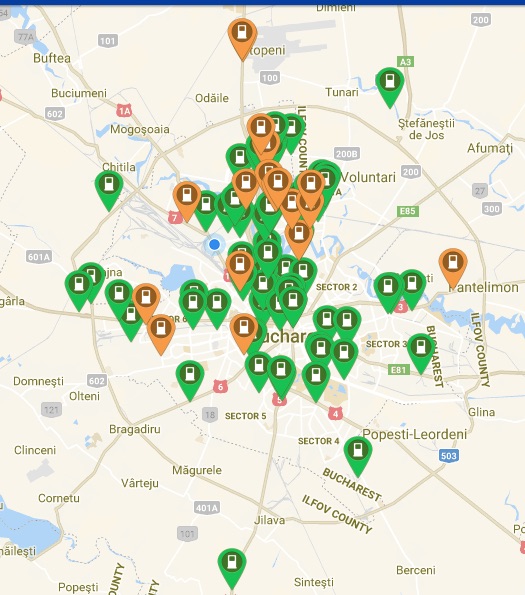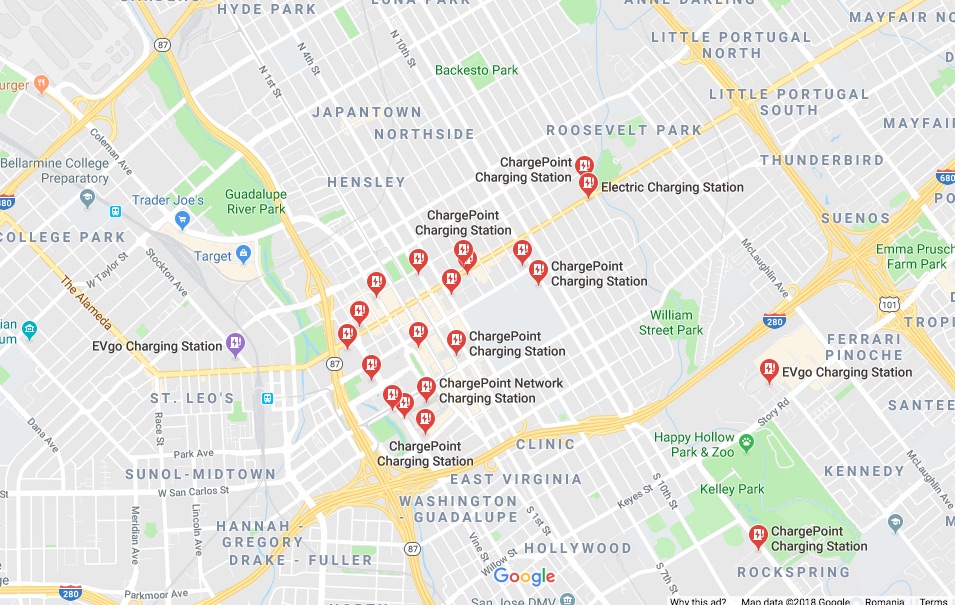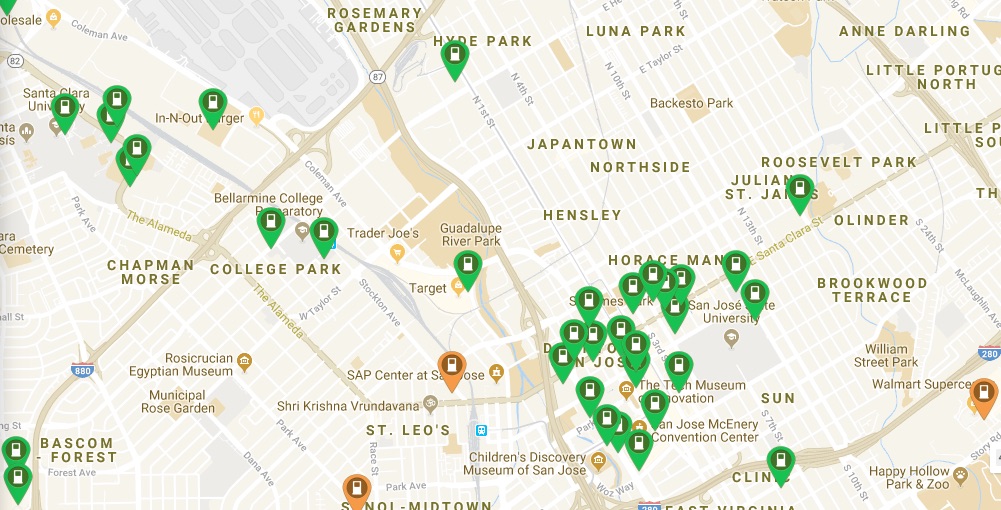Nearly 30 years ago I had the misfortune of being laid off from three separate jobs because Microsoft yawned and stretched a little bit. In one case Microsoft added TCP/IP support to Windows with Win95, which drove out of business the several companies who had sold TCP/IP for Windows – I worked for one of those companies. In other words, a market can be dominated by several small companies but then get the attention of an 800,000 ton gorilla corporation which has a vague thought of “we should add this feature to our product line“. But if that little feature is the lifeblood of an entire company, what does that mean for the future of that company?
There are several companies providing electric car charging station maps![]() , not just Plugshare. Plugshare simply happens to be the most prominent of them. FWIW during 2014 I worked for Recargo, the parent company of Plugshare. I didn’t work on Plugshare, instead I worked on the redesign of PlugInCars.com, but at the time I was proud to be working for the company that owned Plugshare.
, not just Plugshare. Plugshare simply happens to be the most prominent of them. FWIW during 2014 I worked for Recargo, the parent company of Plugshare. I didn’t work on Plugshare, instead I worked on the redesign of PlugInCars.com, but at the time I was proud to be working for the company that owned Plugshare.
Why mention all this? Who cares that before Microsoft added TCP/IP to Windows there were several companies selling that product, and as a consequence I had to scramble for a new job. The world is better off that Microsoft added TCP/IP to Win95 and thereby launched the Internet in a big way, but it meant the destruction of several small companies.
Yesterday, Google added EV Charging Station information to Google Maps![]() . While most of us will go “oh, cool, that’s useful”, there is a predictable effect on Plugshare and the other providers of this service.
. While most of us will go “oh, cool, that’s useful”, there is a predictable effect on Plugshare and the other providers of this service.
This may explain why Recargo allowed itself to be acquired![]() on Oct 2 2018. If there were rumors that Google was making such a move, Recargo may have decided the time was ripe to sell out. The purchaser, innogy eMobility, is a German “energy” company primarily focused on renewable energy.
on Oct 2 2018. If there were rumors that Google was making such a move, Recargo may have decided the time was ripe to sell out. The purchaser, innogy eMobility, is a German “energy” company primarily focused on renewable energy.
EV Charging stations on Google Maps
Enough with the history lesson – let’s take a look at the result.
Go to Google Maps on your favorite device and type in a phrase like “ev charging stations, bucharest, romania“. (If you don’t care about Bucharest, plug in your favorite city) The resulting map is up at the top.
Since I happen to be in Bucharest at the moment I’ve been using Plugshare and happen to know the map is incomplete compared to what Plugshare shows for Bucharest. Namely:

In case you don’t know Bucharest as well as I do …. the Plugshare map is showing a wider area, compare the location of the circle road in both maps. Plugshare shows a lot more stations within the circle, plus it shows stations outside the circle. A lot of these stations, including all the ones outside the circle, simply do not show up on the Google Maps presentation.
As an aside – this is a huge improvement over the state of EV charging near Bucharest over when I began tracking this five years ago. We’re talking about a relatively poor country where owning an EV would be a huge challenge, and look at this charging network. But we’re here to evaluate Google Maps, not the state of electric vehicles in Romania.
Let’s try another … like, downtown San Jose, CA.

This is showing the cluster of charging stations in downtown San Jose, plug the eVgo station at the Whole Foods on The Alameda. But …

This shows quite a few more. Such as the stations clustered around Santa Clara University, at the Target on Coleman Ave, at Bellarmine College, and another one nearby that I hadn’t known about, and so on.
The point of the exercise being that Google Maps doesn’t have as much data as Recargo’s Plugshare, and therefore does not provide as good a service.
Ease of Use
Plugshare’s map is easier to use for this purpose than is Google Maps. With Google Maps every time you change the zoom level or move the map, a button pops up asking if you want the search to be repeated. With Plugshare it automatically redoes the search, showing data for any rectangle you select.
Plugshare has an excellent filtering system letting you select precise types of charging stations. With Google Maps you’re lucky to have the data available, as there is no filtering beyond this.
Mapping trips
A related issue is support for mapping a trip accounting for EV charging stations.
With Plugshare that is a built-in feature that has several years of maturity behind it. As you’d expect from a map application, you give a starting and ending point. With PlugShare you can add in recharging stops, and also you inform the application the range of your vehicle and it will help find charging stations within range. It’s not perfect, but it works pretty well.
With Google Maps, you do have an excellent trip planner that offers several alternatives plus traffic estimates and more. But…. the trip planner does not know about EV charging stations, nor how to account for the driving range of your vehicle.
Bottom line
Clearly the EV Charging station data in Google Maps is inadequate. Not only do competitor services like Plugshare have more data, but they have additional features.
Because the EV charging station data is an afterthought in Google Maps, I don’t expect Google Maps to become competitive with e.g. Plugshare any time soon. Google Maps lacks the ability to filter results on the type of charging station, the ability to plan a trip accounting for EV driving range, and more. As an afterthought feature, neither of those can be fixed without a drastic rethink of the user interface.
Do these deficiencies mean the charging station map vendors should relax and think there’s no problem? Nope.
Most people might not care about or know about the deficiencies, and might be happy with the charging stations that show up on the map.
- Is there enough Grid Capacity for Hydrogen Fuel Cell or Battery Electric cars? - April 23, 2023
- Is Tesla finagling to grab federal NEVI dollars for Supercharger network? - November 15, 2022
- Tesla announces the North American Charging Standard charging connector - November 11, 2022
- Lightning Motorcycles adopts Silicon battery, 5 minute charge time gives 135 miles range - November 9, 2022
- Tesla Autopilot under US Dept of Transportation scrutiny - June 13, 2022
- Spectacular CNG bus fire misrepresented as EV bus fire - April 21, 2022
- Moldova, Ukraine, Georgia, Russia, and the European Energy Crisis - December 21, 2021
- Li-Bridge leading the USA across lithium battery chasm - October 29, 2021
- USA increasing domestic lithium battery research and manufacturing - October 28, 2021
- Electrify America building USA/Canada-wide EV charging network - October 27, 2021














